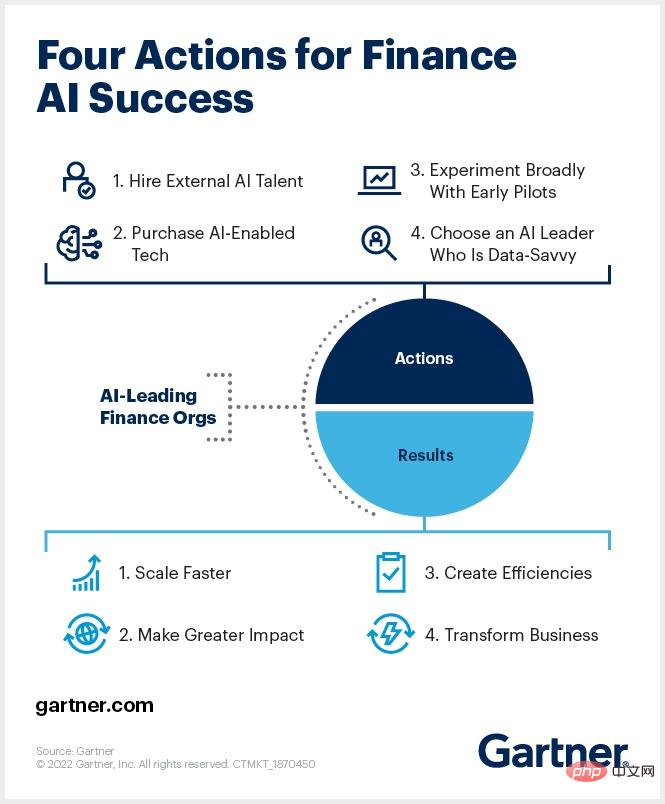 Technology peripherals
Technology peripherals
 AI
AI
 Gartner: Four steps to ensure financial AI applications are implemented correctly
Gartner: Four steps to ensure financial AI applications are implemented correctly
Gartner: Four steps to ensure financial AI applications are implemented correctly

- Artificial intelligence (AI) is increasingly important to finance, but CFOs are still learning when and how to successfully deploy them.
- Investing in artificial intelligence and other digital initiatives can blunt the negative effects of economic stress in the short term and build competitive advantage in the long term.
- In finance, successful AI implementation requires the right leadership, talent, software investment and experimentation.
The use of artificial intelligence remains an emerging priority for CFOs as they move their finance functions further into a digital future. Of those using AI, 75% said they started using it within the past two years.
"The use of artificial intelligence in finance is still in its infancy, and most early adopters have little awareness of the expected returns on such projects," said Alexander Bant, research director at Gartner. “Defining financial use cases is key – for digital initiatives in general and AI projects in particular. Ultimately, the goal is to improve your competitive position and prepare for an autonomous future, especially in today’s economy.”
Gartner research shows that leading AI deployers engage in four common behaviors that enable them to quickly meet or exceed the expected impact of their AI projects and deliver key financial and business results.
“On average, finance departments that took these four actions found twice as many AI use cases as departments that didn’t take these actions,” Bant said. "This translates into more important business results, such as new product lines, and financial department results, such as greater accuracy and shorter process times."

四Key actions to ensure the success of financial artificial intelligence:
1. Hire external AI professionals
There are three options to ensure talent with AI skills and expertise: hire new talent, upgrade existing talent skills or borrow talent from the IT department. Organizations that focus their talent strategies on recruiting external employees with AI skills are more likely to become leading AI finance organizations.
AI specific talent brings valuable experience in handling the nuances of AI. This enables organizations to overcome inertia in using AI
applications and shorten the technology learning curve. While upskilling finance staff may be less expensive, doing so may slow progress and introduce a greater potential for error. New AI professionals change traditional processes and ways of thinking by bringing new ideas to support AI deployments.
2. Invest in software with embedded AI capabilities for quick success
Buy software with embedded AI capabilities to experiment with AI and apply it to financing use cases to quickly build solutions for unique business problems of pilot. Building in-house AI solutions for all financial processes creates more work and less bandwidth to explore new pilots or use cases.
3. Experiment early and widely
Top financial AI organizations take a “quick trial and error” experimental approach to AI deployment rather than making a few big bets. Early leaders will use AI more and deploy it faster.
The three most common AI use cases are accounting processes, back-office processing, and cash flow forecasting. Customer payment forecasting is a use case explored by half of leading organizations, but rarely among less successful organizations.
4. Choose an analytical AI implementation leader
Enterprises must choose the right people to lead AI deployments to realize benefits. This might mean the head of financial planning and analysis (FP&A) or the head of financial analytics leading the AI implementation, rather than the controller.
The FP&A and Financial Analytics leader has successfully led AI with his strong analytics and data background. They rely less on understanding traditional financial processes and more on understanding the complexities of AI in a business environment.
The above is the detailed content of Gartner: Four steps to ensure financial AI applications are implemented correctly. For more information, please follow other related articles on the PHP Chinese website!

Hot AI Tools

Undresser.AI Undress
AI-powered app for creating realistic nude photos

AI Clothes Remover
Online AI tool for removing clothes from photos.

Undress AI Tool
Undress images for free

Clothoff.io
AI clothes remover

AI Hentai Generator
Generate AI Hentai for free.

Hot Article

Hot Tools

Notepad++7.3.1
Easy-to-use and free code editor

SublimeText3 Chinese version
Chinese version, very easy to use

Zend Studio 13.0.1
Powerful PHP integrated development environment

Dreamweaver CS6
Visual web development tools

SublimeText3 Mac version
God-level code editing software (SublimeText3)

Hot Topics
 What are the types of return values of c language function? Summary of types of return values of c language function?
Apr 03, 2025 pm 11:18 PM
What are the types of return values of c language function? Summary of types of return values of c language function?
Apr 03, 2025 pm 11:18 PM
The return value types of C language function include int, float, double, char, void and pointer types. int is used to return integers, float and double are used to return floats, and char returns characters. void means that the function does not return any value. The pointer type returns the memory address, be careful to avoid memory leakage.结构体或联合体可返回多个相关数据。
 How to calculate c-subscript 3 subscript 5 c-subscript 3 subscript 5 algorithm tutorial
Apr 03, 2025 pm 10:33 PM
How to calculate c-subscript 3 subscript 5 c-subscript 3 subscript 5 algorithm tutorial
Apr 03, 2025 pm 10:33 PM
The calculation of C35 is essentially combinatorial mathematics, representing the number of combinations selected from 3 of 5 elements. The calculation formula is C53 = 5! / (3! * 2!), which can be directly calculated by loops to improve efficiency and avoid overflow. In addition, understanding the nature of combinations and mastering efficient calculation methods is crucial to solving many problems in the fields of probability statistics, cryptography, algorithm design, etc.
 distinct function usage distance function c usage tutorial
Apr 03, 2025 pm 10:27 PM
distinct function usage distance function c usage tutorial
Apr 03, 2025 pm 10:27 PM
std::unique removes adjacent duplicate elements in the container and moves them to the end, returning an iterator pointing to the first duplicate element. std::distance calculates the distance between two iterators, that is, the number of elements they point to. These two functions are useful for optimizing code and improving efficiency, but there are also some pitfalls to be paid attention to, such as: std::unique only deals with adjacent duplicate elements. std::distance is less efficient when dealing with non-random access iterators. By mastering these features and best practices, you can fully utilize the power of these two functions.
 What are the differences and connections between c and c#?
Apr 03, 2025 pm 10:36 PM
What are the differences and connections between c and c#?
Apr 03, 2025 pm 10:36 PM
Although C and C# have similarities, they are completely different: C is a process-oriented, manual memory management, and platform-dependent language used for system programming; C# is an object-oriented, garbage collection, and platform-independent language used for desktop, web application and game development.
 What are c language function pointers and pointer functions? What's the difference?
Apr 03, 2025 pm 11:54 PM
What are c language function pointers and pointer functions? What's the difference?
Apr 03, 2025 pm 11:54 PM
A function pointer is a pointer to a function, and a pointer function is a function that returns a pointer. Function pointers point to functions, used to select and execute different functions; pointer functions return pointers to variables, arrays or other functions; when using function pointers, pay attention to parameter matching and checking pointer null values; when using pointer functions, pay attention to memory management and free dynamically allocated memory; understand the differences and characteristics of the two to avoid confusion and errors.
 What are the formats of function definition in C language?
Apr 03, 2025 pm 11:51 PM
What are the formats of function definition in C language?
Apr 03, 2025 pm 11:51 PM
The key elements of C function definition include: return type (defining the value returned by the function), function name (following the naming specification and determining the scope), parameter list (defining the parameter type, quantity and order accepted by the function) and function body (implementing the logic of the function). It is crucial to clarify the meaning and subtle relationship of these elements, and can help developers avoid "pits" and write more efficient and elegant code.
 CS-Week 3
Apr 04, 2025 am 06:06 AM
CS-Week 3
Apr 04, 2025 am 06:06 AM
Algorithms are the set of instructions to solve problems, and their execution speed and memory usage vary. In programming, many algorithms are based on data search and sorting. This article will introduce several data retrieval and sorting algorithms. Linear search assumes that there is an array [20,500,10,5,100,1,50] and needs to find the number 50. The linear search algorithm checks each element in the array one by one until the target value is found or the complete array is traversed. The algorithm flowchart is as follows: The pseudo-code for linear search is as follows: Check each element: If the target value is found: Return true Return false C language implementation: #include#includeintmain(void){i
 How to use C language function pointer to find the maximum value of a one-dimensional array
Apr 03, 2025 pm 11:45 PM
How to use C language function pointer to find the maximum value of a one-dimensional array
Apr 03, 2025 pm 11:45 PM
Flexible application of function pointers: use comparison functions to find the maximum value of an array. First, define the comparison function type CompareFunc, and then write the comparison function compareMax(a, b). The findMax function accepts array, array size, and comparison function parameters, and uses the comparison function to loop to compare array elements to find the maximum value. This method has strong code reusability, reflects the idea of higher-order programming, and is conducive to solving more complex problems.





